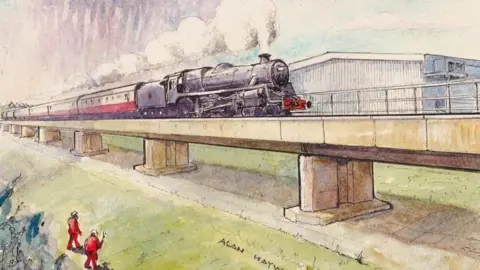Plan to reunite heritage railway takes step forward
 Great Central Railway
Great Central RailwayPlans to reconnect two halves of a heritage railway have been given the go-ahead.
Charnwood Borough Council has approved a planning application to reunite the surviving sections of the Great Central Railway (GCR) and reinstate about 500 metres of railway line.
The proposed development would also connect the Great Central Railway to the national mainline at Loughborough, which would allow historic trains to travel from other parts of the UK to run on to the GCR.
Funds to pay for the project have been raised mainly through regular donations from the public, but railway bosses said they needed "a lot more money" to complete the scheme.
The aim of the wider project is to re-join the surviving sections of the railway between Loughborough and Nottingham to re-connect an 18-mile heritage railway across the East Midlands, planning documents add.
The Great Central Main Line was originally opened in 1899, as a Victorian high-speed railway between Sheffield and London, but it was closed as part of the Beeching railway cuts in the 1960s.
While two long sections of the line through the Midlands remained, 500m (1,640ft) of railway in Loughborough – which connected them together – was demolished.
 Alan Hayward
Alan HaywardPlanning documents say "significant work" to reconnect the line has already taken place, with new bridges over the A60, the Midland Mainline and the full renovation of the canal bridge.
However, GCR said any further work required planning permission, which was granted by Charnwood Borough Council on 16 June.
Work which has been approved includes the construction of a new railway viaduct between the Grand Union Canal Bridge and Railway Terrace.
Andy Fillingham from GCR said: "Reconnecting the two lines will create an eighteen mile long, living history of Britain's railways on the doorsteps of millions of people, telling the stories of how they shaped the nation, from the Victorian era to the 1960s.
"The majority of the work so far has been funded by people making small regular donations. It's people power on an epic scale. With planning permission granted, we need to raise a lot more money to finish the job."
Follow BBC Leicester on Facebook, on X, or on Instagram. Send your story ideas to [email protected] or via WhatsApp on 0808 100 2210.
